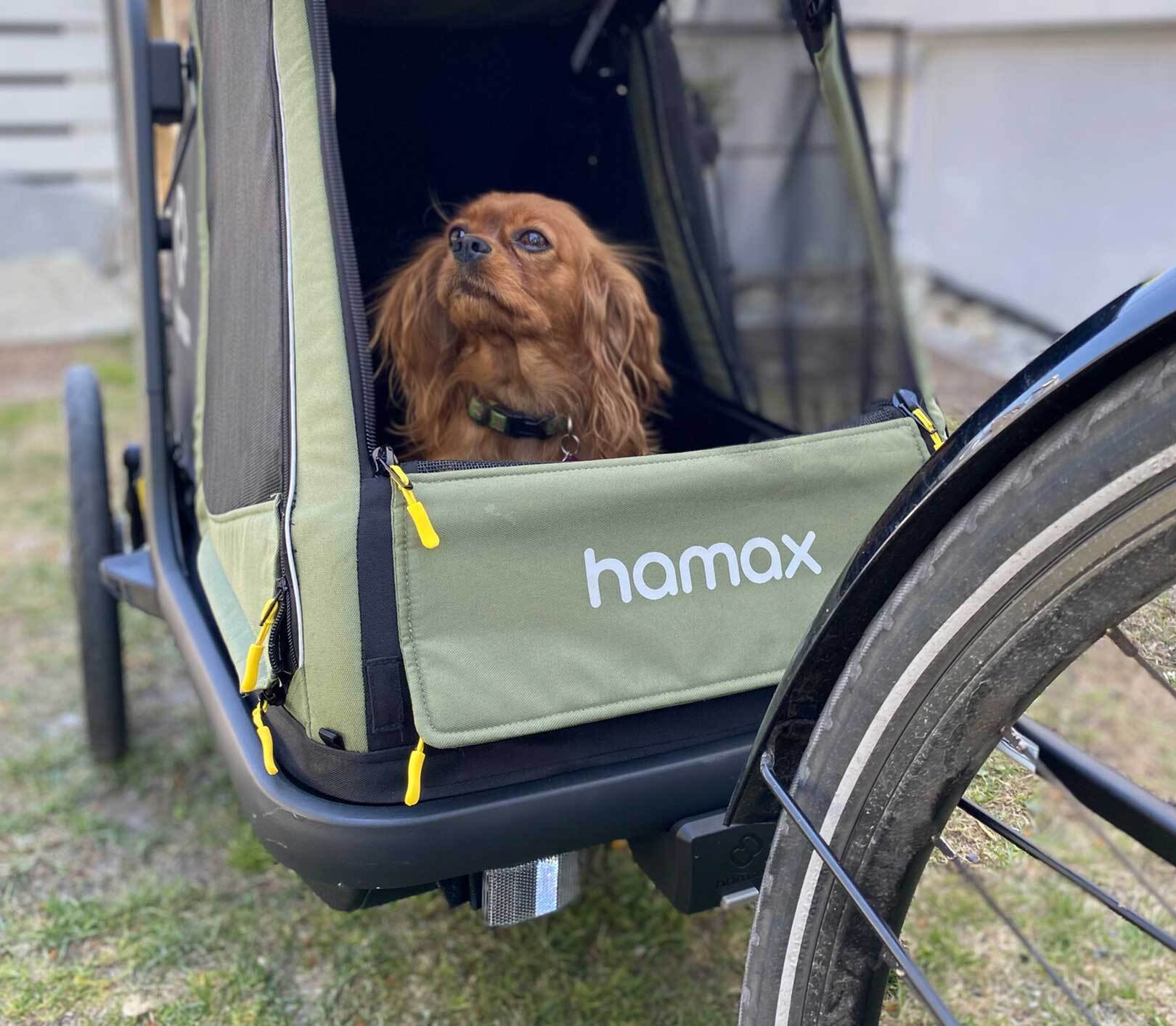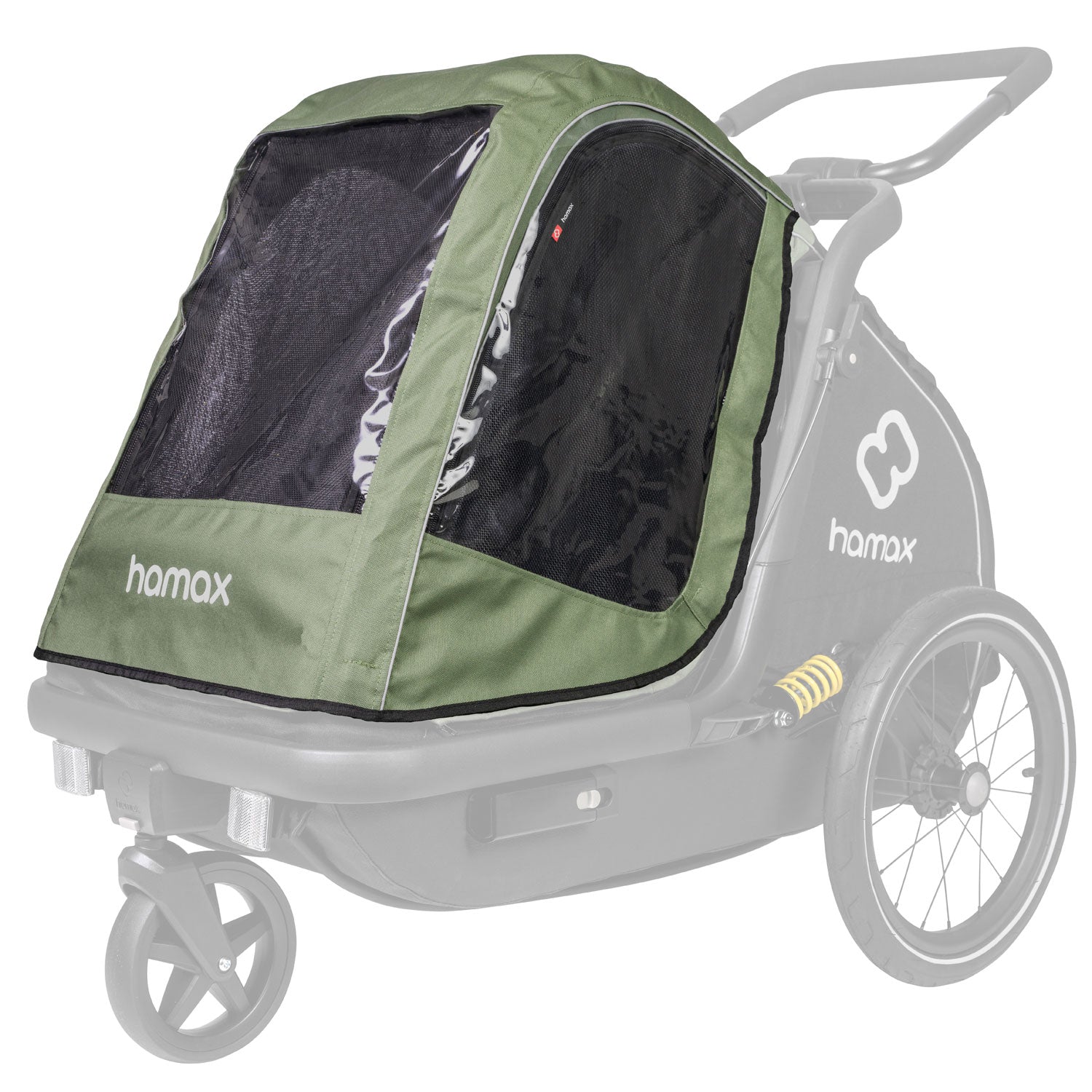Cycling with a dog: what's important
The great weather not only invites you to go for long walks and play activities in the garden at home, as a passionate cyclist you may also be looking forward to varied cycling tours through nature together with your four-legged friend.
It is important to know, however, that some dog breeds should not generally cover long distances at walking pace. These include mainly small breeds such as the Chihuahua or Maltese, as well as heavy breeds such as the English Bulldog. Running dogs and active breeds such as greyhounds, huskies and Malinois, on the other hand, love to trot and run.
We explain how you can cycle safely together through the greenery and what you should keep in mind.
Are you allowed to cycle with your dog?
If you are travelling by bike, you can take your dog with you. However, it is forbidden to drive animals from motor vehicles. When cycling with a dog, safety is paramount - for you, your dog and other road users. You should therefore bear these aspects in mind:
Right running side
Always keep your four-legged friend on your right-hand side in traffic. This will protect him from passing cars that may startle him or whose drivers could easily overlook him.
Do not attach the leash to the bike
You should never attach your four-legged friend to your bike with a lead! There is too great a risk that it will make a jerky movement and cause you to fall - perhaps a squirrel or another dog is just interesting.
Cycling with a leash
It is safer to keep your dog on a leash and hold it with one hand. You should only consider using a dog leash when cycling if you are a safe rider. Always use a chest harness and not a collar, otherwise your furry friend could be seriously injured in uncontrolled situations.
Absolute obedience
Your dog may also run freely alongside your bike while you are riding. However, absolute obedience plays a major role here. Your dog should be able to respond to your commands in any situation and follow you unconditionally, because according to the German Road Traffic Regulations (StVO), he may only accompany you on the bike if you can exert sufficient influence on him - e.g. your dog's recall should also work in the case of attractive distractions such as encounters with wild animals and dogs, so as not to endanger your dog and other road users. Also bear in mind that in some areas or during the breeding season, dogs must be kept on a leash.
Make sure your pet's paws are protected on longer bike rides, when cycling in summer - as the asphalt on the roads can get very hot - or on uneven ground in wooded areas and on stony hiking trails.
Cycling with a dog: The possibilities
You have many options for taking your four-legged friend on extensive cycling tours. Does he accompany you on the bike bar, is he allowed to observe nature from a dog basket on the luggage rack or handlebars, or does he traverse the roads and country lanes with his dog trailer? Which means of transport is best suited for your dog on the bike depends on the following factors, for example:
- Size and weight of your dog
- Age of your dog
- Health condition
- Weather conditions
- Obedience as well as play and hunting instincts.

Bike pole: Training for active dogs
Cycling tours are fun and also train your fitness and muscles. If you also want to keep your four-legged friend's cardiovascular system fit, you may want to choose a bike pole. You should pay attention to this when choosing equipment with a bike pole:
- The bike pole is attached to your bike and serves as a spacer for your dog.
- There is a sturdy spring at the end of the metal bar, to which a leash holder is attached, into which you hook the leash. The spring ensures that any jolt from your dog is not transmitted directly to you and the bike.
- The leash is in turn connected to the dog harness, which should ideally be padded and reflective ( Y-harnesses that can be attached to the back and chest area are particularly suitable).
Your dog is allowed to run on the bike if he:
● fully grown and over 12 months old
● no joint diseases and
● has no cardiovascular problems.
Our tip: If possible, have your pet checked by your vet before the first long bike ride.
Dog bike basket: Adventure trip for small breeds
Bicycle baskets and dog bags are a welcome change for small breeds like the French Bulldog and the Jack Russell Terrier, who can only walk short distances on a bicycle. For old or sick dogs, bicycle baskets are essential as a means of transport so that they can enjoy bike rides and do not overstrain their joints. At the same time, they observe their environment from the handlebars or the luggage rack:
● Dog bike bag on the handlebars
Bags and baskets on the front of the handlebars are particularly popular with those who want to keep an eye on their four-legged friends while cycling. They are suitable for dogs weighing up to a maximum of 12 kg that can be relied on to sit still. This is because consistent wriggling and turning can affect the handlebars and possibly provoke a fall.
● Dog bike basket on the luggage rack
For those who feel more comfortable leaving the handlebars free, a dog basket on the luggage rack is a good idea. This way, the dog can travel along on the bike temporarily or permanently, watch the passing nature and greet approaching road users. Bicycle baskets are usually permitted for dogs weighing up to 20 kg. Here too, movements in the basket can possibly influence your balance - if in doubt, it is worth testing to find out which transport variant suits you better.
Bike trailer for dogs: Cycling tour with large dog breeds
Medium-sized and large dogs with a height of over 40 cm and a weight of over 20 kg can comfortably accompany bicycle tours in the trailer. From here, your pelt-nose can enjoy a full all-round view. When choosing a suitable dog trailer, focus on the size and weight of the trailer. Your pet should be able to sit upright without touching the roof of the trailer. This prevents your dog from hitting his head on uneven ground (e.g. small potholes or roots).
A bike trailer for dogs has these advantages:
- Suitable for every dog: no matter what breed or age - so your darling is always with you,
- Safety for your dog,
- he can rest whenever he wants and still get to see everything,
- With a rain cover, even bad weather is no obstacle.

Getting used to the means of transport
Before your first bicycle tour, you should get your pet used to the new means of transport. However, this can be done in two simple steps:
1. Get to know it:
place the bicycle basket, the bicycle bag or the trailer in your home and let your dog sniff and sniff in peace. If he sits or lies down in it, praise your dog extensively or reward him with a treat. He may prefer his usual dog bed and not get the idea to make himself comfortable in the carrier on his own. In this case, you can lure him with a treat. To do this, simply lay a trail all the way into the basket or trailer.
2. Getting used to it:
If the "dry run" has worked, mount the bike basket/bag on the handlebars or luggage rack or attach the trailer to the bike. Now let your dog get on and push the bike a few metres. If your dog is calm and relaxed, get on and ride slowly and carefully for a short distance, gradually increasing the distance.
Learning to ride a bike with a dog: Walking on a bike
If you want your pet to run alongside you on the bike, this will also take some practice. First get your dog used to the bike and give him the opportunity to find his own pace alongside you on the bike. We explain how to lead your dog on the bike in 3 simple steps:
- Getting your dog used to the bike: Firstly, your dog needs to get to know the bike. To do this, ask someone to accompany you on your next bike ride. Ideally, they should push the bike and let your dog sniff it from time to time. Once your dog is relaxed, ask your helper to get on the bike and ride alongside you.
- Get your dog used to riding: Now pick up the bike yourself and push it alongside you on your next walk, while your dog runs along on a leash or free. If he remains calm, get on the bike and ride a few metres, preferably initially on a quiet training route without distractions. If you want to use a bike pole, mount it before you ride for the first time and let him walk on it. If he remains calm, you can get on the bike.
- Training: The time has come for your furry friend to accompany you on the bike holder, on the leash or on a free run. Start with a short distance and a slow, easily controllable pace. You can gradually increase the distance and adjust the speed so that your dog consistently accompanies you at a relaxed trot.
Our tip: We recommend that you always take a dog trailer or dog basket with you on long journeys in case your four-legged friend injures himself on the way or needs to rest in particularly high temperatures. Give your dog enough breaks and offer him drinking water regularly. For example, a special outdoor drinking bottle with a sikicon bowl is suitable.
Conclusion: Whether large or small, young or old - your dog can accompany you on long bike rides in different ways. With a little training and sufficient habituation, nothing will stand in the way of your joint excursions into the countryside.
What are your experiences: Do you have any tips for successful cycle tours with a dog? What's your favourite way to take your dog with you? We look forward to your experiences!



